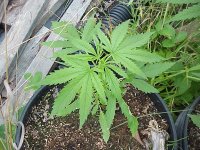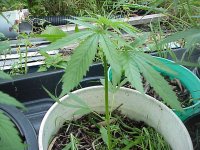Radicle Rye
Active member
Ok so here is a real world example....I first started some '88G13/HP F2 by hazeman. I ended up pollinating one exceptional female with 3 males. I ended up making a bunch of seed.
So I started 10 of my F3's and have one male that has started intersexing once I put them outside ~3 weeks ago. It has only expressed intersex pistils on the very tip of the main cola.

Side branch with no intersexing

One more shot of the top

With an inbred line such as '88G13/HP would you hold onto this male in order to hold onto more genetic diversity? Wondering if this is the type of intersex plant that people are categorizing as "well behaved"?
So I started 10 of my F3's and have one male that has started intersexing once I put them outside ~3 weeks ago. It has only expressed intersex pistils on the very tip of the main cola.
Side branch with no intersexing
One more shot of the top
With an inbred line such as '88G13/HP would you hold onto this male in order to hold onto more genetic diversity? Wondering if this is the type of intersex plant that people are categorizing as "well behaved"?






